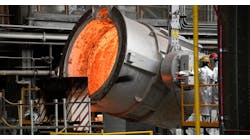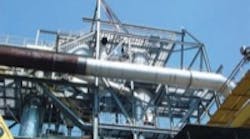A new 38 ton/hour cupola melt system with state-of the-art pollution control has been designed for China's Weichai Power Ltd., to provide molten metal for producing 10-13-liter engine blocks. Weichai is one of the largest domestic producers of diesel engines in that country, supplying blocks for heavy-duty vehicles and buses, construction machinery, generators, and other applications — but its gray-iron production processes are responsible for many pollution problems that characterize China's heavy industies.
The new cupola system was developed by a partnership of U.S. firms, led by Electric Controls & Systems Inc. (EC&S), Birmingham, AL. EC&S is responsible for integrating the individual molten-metal-production equipment, and its partners include:
- Kodiak Group, Grayling, MI, as design engineer and supplier of various equipment;
- Wrib Manufacturing, Danville, IL, supplying a long-campaign cupola (10-12 weeks) and blower to feed air to the cupola;
- Maumee Valley Fabricators Inc., Escher division, Toledo, OH, responsible for a hot-gas recuperator and waste-gas coolers;
- And, GMD Environmental Technologies Inc., Fort Worth, TX, providing bag house emission-control equipment.
China has thousands of cupolas, but most melt only 2 to 5 ton/hour with short campaign lengths of just a few hours, or a few days at most, and none offer extensive integrated emission control. Contrast that with U.S. iron foundries, averaging about 35 ton/hour melt rates with multi-day campaigns and the latest in emissions-control technology. With three bidders on this project, the winning team was able to harness the leading-edge technologies of each project partner. And, because Wichita Power wanted its suppliers to match the environmental standards required in suppliers' home countries, the cupola design boasts emission controls in line with MACT (maximum achievable control technology) standards and other related U.S. EPA requirements.
So what will Wichita Power get for its investment? "The long-campaign scrap-charge cupola will operate between 10 and 12 weeks before it drops bottom," says Rick Rubin, co-owner of Rib Manufacturing. "I read some articles dealing with foundries in this particular area of China where this cupola will be installed, and one company brags that it can melt three tons per hour. This one can spill more than that. And they have not heard of a campaign length of much over two days. This will really be something for them to see."
Escher is supplying the hot-gas recuperate, according to Robert Scullery, project manager for Escher, as well as waste-gas coolers located downstream from the recuperator, to cool gases down from about 1,100°F for baghouse filtering.
"The heat generated by burning carbon monoxide in the combustion chamber is utilized in the hot-blast recuperator to preheat combustion air to be returned into the cupola," Schuler explains. "That amounts to about 17,000 standard cubic feet per minute of air being preheated to 1,000°F."
Waste gases cool from about 1,500°F to 1,100°F by the time they reach the flue-gas coolers prior to entering the baghouse units. "Chinese companies are not well-versed in recuperative hot-blast furnaces, waste flue- gas cooling and baghouse technology," he says. "This is new technology for them."
GMD Environmental is supplying what Gerald Reier, president, describes as the cupola emission-reduction system.
"It consists of eight modular baghouses, and each has approximately 300 bags fabricated from DuPont Nomex," says Reier. "We are furnishing everything from the inlet manifold — the air inlet for the dust collectors — through the exhaust stack. That includes those baghouses, related ducting, dampering equipment, the induced-draft fan and the stack.
"Until recently," Reier continues, "Chinese foundries have not even looked at meeting the kind of emission-control standards that we provide with our equipment."
Kodiak Group is responsible for project design engineering, including all of the mechanical and structural layouts and details.
"We are designing all of the flue-gas flows, including the combustion-air requirements, and also designing for the additives system, which would be the coal conversion," explains Howard Wood, Kodiak Group president, noting that his company's scope on the project includes practically designing the Btus throughout the entire system. That coal-conversion facet includes everything from coal hoppers under the ‘grizzly' grid to vibratory equipment that feeds the elevating conveyors. "Some of the conveyors we are designing inhouse, and some are being purchased," he adds.
Also designed by Kodiak Group: the weigh system for the coke, stone and scrap metal; scrap-yard trim deck; cupola charge system and structural tower. The company also is supplying equipment such as the below-charge takeoff, charge bucket, charge car and charge-bucket bail.
EC&S is providing integration of all individual system components via inhouse-designed controls.
"We are integrating from the main incoming power all the way down to the control power plus the actual control system," explains Bray. "We'll make sure that the cupola works as an individual piece of equipment but at the same time works in conjunction with the recuperator cooler and the baghouse. If there's an upset condition or something happens, every system component changes its conditions to match up."
The project partners describe the Weichai Power cupola installation as a close cousin to one installed at Ward Manufacturing's steel coupling plant in Blossburg, PA, and they explain that it has been their united effort in response to emerging iron-and-steel MACT standards that has resulted in numerous successful cupola projects, chiefly in the U.S., since 2000.
Besides Ward Manufacturing, the team's projects include Tyler Pipe, Tyler, TX, and Griffin Pipe, Lynchburg, VA, and American Brass & Iron, Oakland, CA.
"Back when the EPA started talking about the new MACT standards around 2000, I contacted these major foundry-equipment suppliers and said, ‘Something is going to happen here and there is going to be a lot of work coming up on cupolas,'" recalls Bray. "Electric Controls & Systems had done work individually with all of these companies and they had, in turn, worked with each other individually on various projects. We got together and decided on a team approach and they asked that I lead the team. We actually do not have anything formally signed between us, but have stuck together for these projects."
"We are the latecomer into this group, but had been part of the MACT standards early on and in a substantial way because we were involved in foundry projects used in MACT evaluations," says GMD Environmental's Reier. "Resulting from the impending MACT standards, Greg Bray opened a conversation with me and asked if I thought GMD Environmental would want to be a part of the team. It was no-brainer; this is a significant pool of talent that has been put together."
The partnership's unique capabilities spanning cupola construction and operation have enabled project successes worldwide, according to team-member officials, and the Weichai Power installation has demonstrated that U.S firms can succeed in bringing back Chinese contracts—and dollars—to the American manufacturing landscape.
Read the complete presentation, "Faster and Cleaner Iron Melting … on its way to China."









